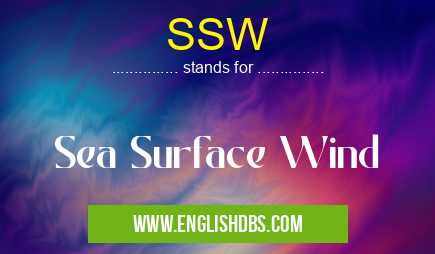What does SSW mean in UNCLASSIFIED
SSW is an abbreviation that stands for Sea Surface Wind. It refers to the wind that blows over the surface of the ocean. SSW is a meteorological term that is used in weather forecasting and climate research.

SSW meaning in Unclassified in Miscellaneous
SSW mostly used in an acronym Unclassified in Category Miscellaneous that means Sea Surface Wind
Shorthand: SSW,
Full Form: Sea Surface Wind
For more information of "Sea Surface Wind", see the section below.
SSW in Marine Forecasting
In marine forecasting, SSW is used to describe the direction and speed of the wind at the surface of the ocean. The direction of the wind is determined by the compass point from which it is blowing, while the speed is measured in knots or meters per second. SSW is an important factor in marine navigation, as it can affect the speed and direction of a vessel.
SSW in Climate Research
In climate research, SSW is used to study the global wind patterns and their impact on climate. SSW data is collected from weather stations, buoys, and satellite measurements. This data is used to create climate models that can simulate past, present, and future wind patterns. SSW is also used to study the interaction between the atmosphere and the ocean, and its role in climate variability and change.
Essential Questions and Answers on Sea Surface Wind in "MISCELLANEOUS»UNFILED"
What is Sea Surface Wind (SSW)?
Sea Surface Wind (SSW) refers to the horizontal motion of air just above the ocean's surface. It is driven by various factors, including pressure gradients, the Coriolis effect, and surface temperature differences. SSW plays a crucial role in ocean-atmosphere interactions and influences weather patterns and marine ecosystems.
How is Sea Surface Wind measured?
SSW can be measured using a variety of methods, including:
- Buoys equipped with anemometers and other sensors
- Ships' weather observations
- Satellite-based remote sensing
- Numerical weather prediction models These measurements provide valuable data for understanding wind patterns, forecasting weather, and supporting marine operations.
What factors influence Sea Surface Wind?
Several factors influence SSW, including:
- Pressure gradients: Differences in atmospheric pressure create wind as air moves from high-pressure to low-pressure areas.
- Coriolis effect: The Earth's rotation deflects winds, resulting in a curving wind pattern.
- Surface temperature differences: Variations in sea surface temperatures can generate thermal gradients, leading to wind flow.
- Land-sea interactions: The presence of landmasses can alter wind patterns, creating local effects such as sea breezes and land breezes.
Why is Sea Surface Wind important?
SSW has significant implications for various aspects:
- Ocean-atmosphere interactions: SSW influences heat and moisture exchange between the ocean and atmosphere, affecting weather patterns and climate.
- Marine ecosystems: Wind-driven currents and upwelling processes support marine life by bringing nutrient-rich waters to the surface.
- Navigation and shipping: SSW affects ship movements and safety, influencing shipping routes and operations.
- Renewable energy: SSW is a key factor in the generation of wind energy over the oceans, contributing to renewable energy production.
Final Words: SSW is an abbreviation that stands for Sea Surface Wind. It is a meteorological term that is used in weather forecasting and climate research. SSW is an important factor in marine navigation and climate modeling, and it provides valuable information for understanding the global wind patterns and their impact on climate.
SSW also stands for: |
|
| All stands for SSW |
